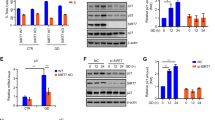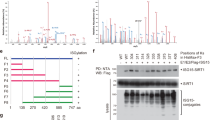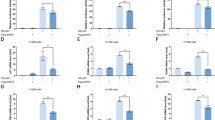Abstract
SIRT1 is an NAD-dependent deacetylase critically involved in stress responses, cellular metabolism and, possibly, ageing1,2,3,4,5,6,7,8,9,10,11,12,13,14,15. The tumour suppressor p53 represents the first non-histone substrate functionally regulated by acetylation and deacetylation16,17; we and others previously found that SIRT1 promotes cell survival by deacetylating p53 (refs 4–6). These results were further supported by the fact that p53 hyperacetylation and increased radiation-induced apoptosis were observed in Sirt1-deficient mice10. Nevertheless, SIRT1-mediated deacetylase function is also implicated in p53-independent pathways under different cellular contexts, and its effects on transcriptional factors such as members of the FOXO family and PGC-1α directly modulate metabolic responses1,2,3,4,5,6,7,8,9,10,11,12,13,14,15. These studies validate the importance of the deacetylase activity of SIRT1, but how SIRT1 activity is regulated in vivo is not well understood. Here we show that DBC1 (deleted in breast cancer 1) acts as a native inhibitor of SIRT1 in human cells. DBC1-mediated repression of SIRT1 leads to increasing levels of p53 acetylation and upregulation of p53-mediated function. In contrast, depletion of endogenous DBC1 by RNA interference (RNAi) stimulates SIRT1-mediated deacetylation of p53 and inhibits p53-dependent apoptosis. Notably, these effects can be reversed in cells by concomitant knockdown of endogenous SIRT1. Our study demonstrates that DBC1 promotes p53-mediated apoptosis through specific inhibition of SIRT1.
This is a preview of subscription content, access via your institution
Access options
Subscribe to this journal
Receive 51 print issues and online access
$199.00 per year
only $3.90 per issue
Buy this article
- Purchase on Springer Link
- Instant access to full article PDF
Prices may be subject to local taxes which are calculated during checkout




Similar content being viewed by others
References
Bordone, L. & Guarente, L. Calorie restriction, SIRT1 and metabolism: understanding longevity. Nature Rev. Mol. Cell Biol. 6, 298–305 (2005)
North, B. J. & Verdin, E. Sirtuins: Sir2-related NAD-dependent protein deacetylases. Genome Biol. 5, 224.1–224.12 (2004)
Baur, J. A. & Sinclair, D. A. Therapeutic potential of resveratrol: the in vivo evidence. Nature Rev. Drug Discov. 5, 493–506 (2006)
Luo, J. et al. Negative control of p53 by Sir2alpha promotes cell survival under stress. Cell 107, 137–148 (2001)
Langley, E. et al. Human SIR2 deacetylates p53 and antagonizes PML/p53-induced cellular senescence. EMBO J. 21, 2383–2396 (2002)
Vaziri, H. et al. hSIR2(SIRT1) functions as an NAD-dependent p53 deacetylase. Cell 107, 149–159 (2001)
Motta, M. C. et al. Mammalian SIRT1 represses forkhead transcription factors. Cell 116, 551–563 (2004)
Brunet, A. et al. Stress-dependent regulation of FOXO transcription factors by the SIRT1 deacetylase. Science 303, 2011–2015 (2004)
Kitamura, Y. I. et al. FoxO1 protects against pancreatic beta cell failure through NeuroD and MafA induction. Cell Metab. 2, 153–163 (2005)
Cheng, H. L. et al. Developmental defects and p53 hyperacetylation in Sir2 homolog (SIRT1)-deficient mice. Proc. Natl Acad. Sci. USA 100, 10794–10799 (2003)
Chen, W. Y. et al. Tumor suppressor HIC1 directly regulates SIRT1 to modulate p53-dependent DNA-damage responses. Cell 123, 437–448 (2005)
Yeung, F. et al. Modulation of NF-kappaB-dependent transcription and cell survival by the SIRT1 deacetylase. EMBO J. 23, 2369–2380 (2004)
Greene, W. C. & Chen, L. F. Regulation of NF-kappaB action by reversible acetylation. Novartis Found. Symp. 259, 208–217; discussion 218–225. (2004)
Rodgers, J. T. et al. Nutrient control of glucose homeostasis through a complex of PGC-1α and SIRT1. Nature 434, 113–118 (2005)
Cohen, H. Y. et al. Acetylation of the C terminus of Ku70 by CBP and PCAF controls Bax-mediated apoptosis. Mol. Cell 13, 627–638 (2004)
Gu, W. & Roeder, R. G. Activation of p53 sequence-specific DNA binding by acetylation of the p53 C-terminal domain. Cell 90, 595–606 (1997)
Luo, J., Su, F., Chen, D., Shiloh, A. & Gu, W. Deacetylation of p53 modulates its effect on cell growth and apoptosis. Nature 408, 377–381 (2000)
Hamaguchi, M. et al. DBC2, a candidate for a tumor suppressor gene involved in breast cancer. Proc. Natl Acad. Sci. USA 99, 13647–13652 (2002)
Sundararajan, R., Chen, G., Mukherjee, C. & White, E. Caspase-dependent processing activates the proapoptotic activity of deleted in breast cancer-1 during tumor necrosis factor-alpha-mediated death signaling. Oncogene 24, 4908–4920 (2005)
North, B. J., Marshall, B. L., Borra, M. T., Denu, J. M. & Verdin, E. The human Sir2 ortholog, SIRT2, is an NAD+-dependent tubulin deacetylase. Mol. Cell 11, 437–444 (2003)
Knowles, M. A., Aveyard, J. S., Taylor, C. F., Harnden, P. & Bass, S. Mutation analysis of the 8p candidate tumour suppressor genes DBC2 (RHOBTB2) and LZTS1 in bladder cancer. Cancer Lett. 225, 121–130 (2005)
Heltweg, B. et al. Antitumor activity of a small-molecule inhibitor of human silent information regulator 2 enzymes. Cancer Res. 66, 4368–4377 (2006)
Olaharski, A. J. et al. The flavoring agent dihydrocoumarin reverses epigenetic silencing and inhibits sirtuin deacetylases. PLoS Genet 1, e77 (2005)
Mai, A. et al. Design, synthesis, and biological evaluation of sirtinol analogues as class III histone/protein deacetylase (Sirtuin) inhibitors. J. Med. Chem. 48, 7789–7795 (2005)
Lagouge, M. et al. Resveratrol improves mitochondrial function and protects against metabolic disease by activating SIRT1 and PGC-1alpha. Cell 127, 1109–1122 (2006)
Baur, J. A. et al. Resveratrol improves health and survival of mice on a high-calorie diet. Nature 444, 337–342 (2006)
Howitz, K. T. et al. Small molecule activators of sirtuins extend Saccharomyces cerevisiae lifespan. Nature 425, 191–196 (2003)
Kaeberlein, M. et al. Substrate-specific activation of sirtuins by resveratrol. J. Biol. Chem. 280, 17038–17045 (2005)
Borra, M. T., Smith, B. C. & Denu, J. M. Mechanism of human SIRT1 activation by resveratrol. J. Biol. Chem. 280, 17187–17195 (2005)
Viswanathan, M., Kim, S. K., Berdichevsky, A. & Guarente, L. A role for SIR-2.1 regulation of ER stress response genes in determining C. elegans life span. Dev. Cell 9, 605–615 (2005)
Acknowledgements
We thank R. Baer for suggestions on this manuscript. We also thank E. White, M. Wigler and E. Verdin for reagents. This work was supported in part by Ellison Medical Foundation and grants from the National Institutes of Health/National Cancer Institute to J.Q. and W.G.
Author information
Authors and Affiliations
Corresponding author
Supplementary information
Supplementary Information
The file contains Supplementary Figures S1 – S14 with Legends and Supplementary Methods. (PDF 1447 kb)
Rights and permissions
About this article
Cite this article
Zhao, W., Kruse, JP., Tang, Y. et al. Negative regulation of the deacetylase SIRT1 by DBC1. Nature 451, 587–590 (2008). https://doi.org/10.1038/nature06515
Received:
Accepted:
Issue Date:
DOI: https://doi.org/10.1038/nature06515
This article is cited by
-
SIRT1 ISGylation accelerates tumor progression by unleashing SIRT1 from the inactive state to promote its deacetylase activity
Experimental & Molecular Medicine (2024)
-
Multifaceted roles of CCAR family proteins in the DNA damage response and cancer
Experimental & Molecular Medicine (2024)
-
SIRT1 mediates breast cancer development and tumorigenesis controlled by estrogen-related receptor β
Breast Cancer (2024)
-
The underlying molecular mechanisms and prognostic factors of RNA binding protein in colorectal cancer: a study based on multiple online databases
Cancer Cell International (2021)
-
Phospholipase D2 is a positive regulator of sirtuin 1 and modulates p53-mediated apoptosis via sirtuin 1
Experimental & Molecular Medicine (2021)
Comments
By submitting a comment you agree to abide by our Terms and Community Guidelines. If you find something abusive or that does not comply with our terms or guidelines please flag it as inappropriate.



